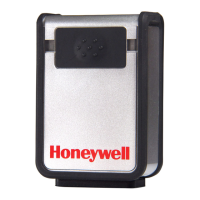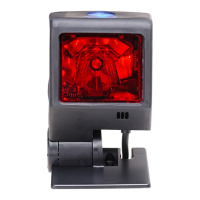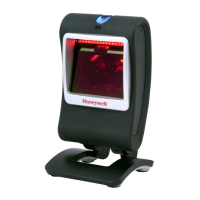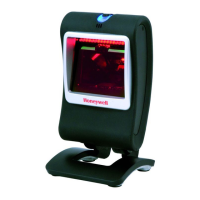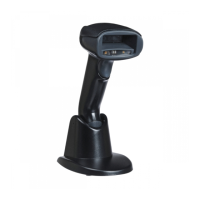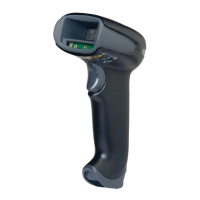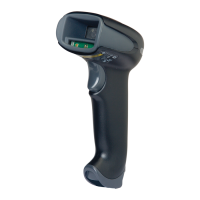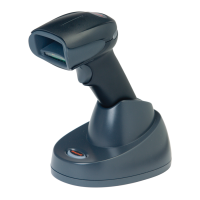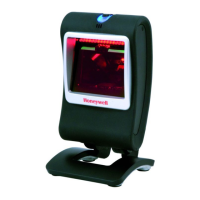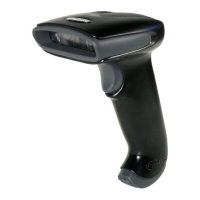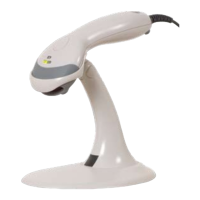Do you have a question about the Honeywell 3820 and is the answer not in the manual?
Lists available scanner and base models with their interfaces.
Information on the integrated rechargeable battery and its charging.
Steps to establish communication between the scanner and the base unit.
Details on using the scanner in Locked Link and Open Link modes.
Explains how to assign scanners to work groups for settings management.
Explains the fundamental interaction between scanner, base, and host.
How to program the scanner with a specific terminal identification number for compatibility.
Lists compatible terminals and their corresponding Terminal IDs for connection setup.
How to set the keyboard layout for different countries to ensure correct character input.
Options for programming keyboard styles like Caps Lock and Shift Lock for input customization.
Configuration options for beeper and LED feedback upon successful scans.
Explains how to activate the scanner using trigger or serial commands for different scanning methods.
Feature to narrow the scanner's field of view for precise barcode reading and selection.
Setting priority for specific barcode symbologies when multiple are present on a label.
How to add characters before or after scanned data to build message strings.
Options for adding or clearing prefixes for all or specific symbologies.
Options for adding or clearing suffixes for all or specific symbologies.
Settings to slow data transmission between characters/functions/messages for integrity.
Introduction to customizing output data formats for scanned barcodes using the editor.
Details on commands used within the Data Format Editor for data manipulation.
Options for enabling/disabling data formatting for barcode output based on requirements.
Using different data formats for single barcode scans, reverting to primary after.
How to enable decoding of all supported barcode symbologies or specific ones.
Setting minimum and maximum lengths for barcode data to ensure accurate reads.
Settings for Codabar symbology, including start/stop characters and check digits.
Settings for Code 39 symbology, including start/stop characters and check digits.
Settings for Interleaved 2 of 5 symbology, including check digits and message length.
Settings for Code 128 symbology, including ISBT concatenation and message length.
Mapping of function codes, hex/ASCII values, and CTRL+ key combinations for terminals.
Tables detailing interface key mappings for various terminal types and emulations.
Temporarily adds symbology ID to decoded data before the symbology name.
Resets the scanner and re-links it with the base unit to resolve communication issues.
Generates a report of connected scanners including port, group, name, and address.
Restores factory default settings for the current work group to resolve configuration issues.
Overview of the PC-based software for scanner programming and configuration.
Explains software functions like Scan Data, Configure, and Imaging for scanner management.
Step-by-step guide for downloading and installing the Visual Xpress software.
Explains the structure and syntax for menu and query commands sent via serial interface.
Details on using special characters to query device settings and retrieve configuration information.
Commands to activate and deactivate the scanner via serial interface for automated scanning.
Detailed technical specifications for the 3820 scanner model, including dimensions and performance.
Detailed technical specifications for the 3820i scanner model, including dimensions and performance.
Pinout details for various interface cables like Keyboard Wedge, Wand Emulation, Serial, and USB.
Instructions for cleaning the scanner window and housing to maintain reading performance.
Step-by-step instructions for safely replacing the scanner's interface cable.
Guidance for diagnosing and resolving common issues with the scanner base unit's functionality.
Contact information for technical support and troubleshooting assistance by region.
Information on obtaining warranty or non-warranty service and return authorization.
Details on Honeywell's product warranty terms, conditions, and duration.
Reference table mapping symbologies to their Code IDs, AIM IDs, and Hex IDs for configuration.
Chart mapping ASCII characters to decimal, hex, and keyboard key combinations for data editing.
Controls automatic re-linking of the scanner after connection loss for continuous operation.
Sets the limit for how many times the scanner attempts to connect to prevent interference.
Configures the idle time between re-link attempts to manage connection behavior.
| Type | Handheld bar code reader |
|---|---|
| Sensor type | CCD |
| Scanner type | 1D/2D |
| Read rate (max) | 270 reads/s |
| Maximum scan width | 610 mm |
| Pitch reading angle | -65 - 65 ° |
| Motion tolerance (cm/s) | 5 |
| Light levels (direct sunlight) | 0 - 70000 lx |
| Linear (1D) barcodes supported | CPC Binary, Codabar, Code 11, Code 128, Code 32, Code 39, Code 93, EAN-13, EAN-8, GS1-128 (UCC/EAN-128), ITF-14, JAN, MSI, Pharmacode, Plessey, Telepen, U.P.C. |
| 2D (matrix & stacked) barcodes supported | Codablock, Code 16K, Code 49, Composite Codes, Data Matrix, PDF417 |
| Battery life | 16 h |
| Charging time | 4 h |
| Input voltage | 12 V |
| Battery voltage | 3.7 V |
| Battery capacity | 1800 mAh |
| Power consumption | 852 mA |
| Power source type | Battery, DC |
| Number of reads per charge | 57000 |
| Power consumption (standby) | 1.2 W |
| Power consumption (typical) | 9.9 W |
| Number of batteries supported | 1 |
| USB version | 2.0 |
| PC connection | USB 2.0 |
| Wireless range | 10 m |
| Bluetooth version | 2.0+EDR |
| Connectivity technology | Wireless |
| Product color | Gray |
| Housing material | Plastic |
| Protection features | Dust resistant, Water resistant |
| Programming function | Yes |
| International Protection (IP) code | IP41 |
| Storage temperature (T-T) | -40 - 60 °C |
| Operating temperature (T-T) | 0 - 50 °C |
| Operating relative humidity (H-H) | 0 - 95 % |
| Depth | 165 mm |
|---|---|
| Width | 81 mm |
| Height | 157 mm |
| Weight | 261 g |

